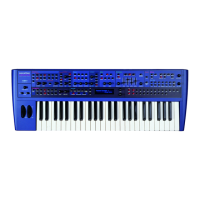Delay Time. This parameter controls the amount of time it takes for the delayed signal to be heard after the original signal. In the
example given above this is the same effect as the distance you are from the wall. A large distance produces a long delay & a
short distance produces a short delay. In the Supernova II Rack, the Delay time is the time of the longest delay. The shorter delay
will be a percentage of this value. See “Ratio” below.
Feedback. This parameter controls how much of the delayed signal is fed back into the delay’s input. No feedback produces a
“Slapback Echo” effect, that is just one delayed signal with no repeats. Small amounts of feedback produce “repeated” signals giv-
ing the “Echo” effect. This can be thought of as standing in-between two parallel concrete walls. The sound bounces back & forth
between them. In this case the Decay Time represents the distance between the walls.
HF Damping. HF Damping is short for High Frequency Damping. This controls the “tone” of the decaying Echo. This can be
thought of as the amount of drapes on the walls. Drapes tend to absorb high frequencies so as a sound “bounces” from wall to wall
, giving you your Echo effect, with each bounce the sound looses a little treble. No HF Damping is a little unusual in the “real” world
but can be used to emphasise sibilant or trebly sounds. This characteristic was found in older “Tape” based echo units. Higher val-
ues of this parameter simulates the effect of worn out tape or heads in a tape echo. Normally a little HF Damping is applied to give
the Echo a natural kind of sound.
Delay Ratio. The Ratio parameter automatically adjusts the “Ratio” of the Longest Delay time & the shorter Delay time into timings
that are useful for Musical use. This parameter does not effect the Delay Time parameter but does alter the shorter Delay time so
that it works well with the Delay Time setting.
Width is the Stereo spread between the long & shorter Delay times. At a width of 0, both delays appear in the middle of the stereo
field. (Mono) At a width of 127, the long delay will appear on one output & the shorter delay on the other producing a dramatic
stereo effect.
Pan.
This effect controls where the sound “sits” in the stereo field. In the Supernova II Rack this performs exactly the same function as
Pan does on a Mixing console. It can be used to statically position a sound anywhere from Left to Right in the stereo field. This (
as everything else on Supernova II Rack ) can be controlled via MIDI controllers.
Pan Type determines if the Pan is set to Pan automatically. If set to “Autopan” the sound will swing from side to side of the stereo
field at a rate determined by the Speed parameter. If set to “Tremolo” the sound goes up & down in volume at a rate determined by
the Speed parameter.
Pan Speed determines the speed of the Autopan & Tremolo effects.
Pan Depth determines how much the Autopan & Tremolo effects control the Volume of the sound, small amounts produces subtle
movements & full amount produces change from no sound to full volume.
A Translation of terms used throughout this manual.
ABOUT EFFECTS
21

